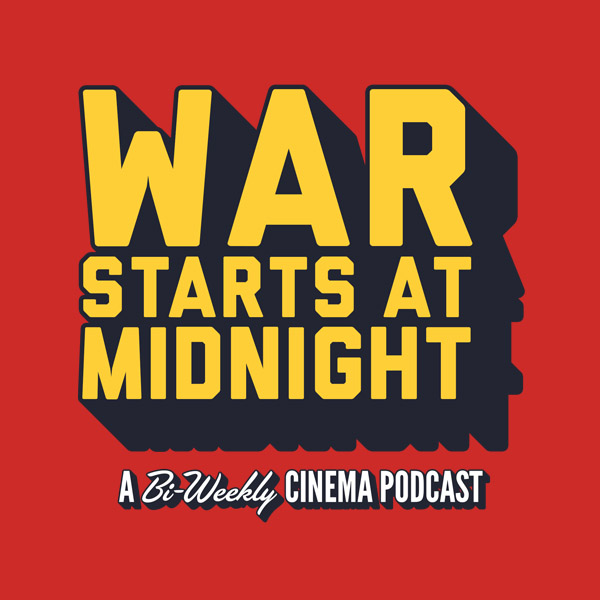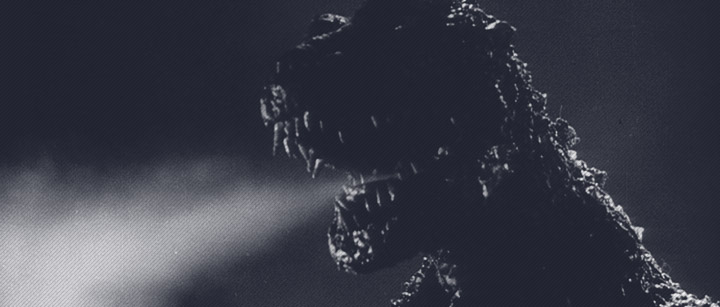This post is part of our weekly newsletter, the Midweek Memo. Subscribe to it here.
Inspired by a bet way back when at Episode 13, I have decided to take on the challenge with the top 5 reasons why Godzilla: King of the Monsters stomps the original Japanese Godzilla.
“Shameless click-bait” you say?
Absolutely.
Nobody reads the intro to these things anyway, so lets get started!
#5 – THE BEGINNING

“What the hell could’ve done this?” – Audience Member.
Seems like a good place to start.
G’54 and G:KOTM tell the same story, but in two fundamentally different ways. The former is told in real-time. It starts with a fishing trawler being attacked by a blinding bright light, and never lets up. You the viewer are learning about the monster the same time as the characters. The result is a pace that is dynamic and urgent.
G:KOTM is told after the monster has already destroyed Tokyo. And unlike G’54, which is straight narrative, G:KOTM has a narrator (more about him in a moment).
By showing the carnage in the very first scene, the viewer is left wondering “What the hell could have done this?” Finding out brings mystery and suspense to the story.
I won’t go so far as to say this approach is better. But it is certainly a creative way to tell the story.
#4 – RAYMOND BURR AS “STEVE MARTIN”

Look at that performance – even the man’s SWEAT is acting!
“I’m saying a prayer George, a prayer for the whole world.”
Man, oh man that speech still gives me geekbumps.
Before Ironside, before Perry Mason, before he was ranked #44 on TV Guide’s “Greatest TV Stars of All Time”, (but after Rear Window), ursine and avuncular actor Raymond Burr played intrepid reporter Steve Martin in G:KOTM. In the process he created what is undoubtedly one of the most memorable (human) characters in the entire franchise.
Consider the gravity Burr brought to the role. The impact he made on me and countless other first-time viewers was immeasurable. He got the tone of the original Godzilla, and alongside G:KOTM director Terry O. Morse, created a movie that made you believe these events really happened.
For millions of American 5-year olds just like me, Burr was our entry point not only into this film, but the incredible world of Godzilla and Japanese man-in-suit cinema.
Raymond Burr was such a baller, he returned to the sequel – Godzilla 1985 – 30 years later. From the looks of it, he was doing a world-class Orson Welles impression.
#3 KING OF THE MONSTERS

A subtitle so badass it’s literally melting the title!
The Man of Steel. The Dark Knight. The Eighth Wonder of The World. The King of the Monsters.
Nowhere did I mention the names of the characters those monikers refer to – but in each instance you knew exactly who I was talking about, right?
A character’s nickname is almost important as his name. It adds to his mystique, his aura, his legend – both in the world of fiction in which the character resides, and in the real world we occupy as fans.
“King of the Monsters” originated with G:KOTM , and has been with the character ever since. In fact, it even made it into the 2014 reboot (I don’t expect “Savior of our City” to take off).
What I love about this title is all that it implies – G:KOTM wanted to make a statement. Frankenstein, King Kong, Dracula, the Mummy, the Beast From 20,000 Fathoms, all movie monsters ever made were mere subjects when compared to the King.
That’s badass – and brilliant marketing. It was so effective, it has been with the character ever since.
#2 THE NAME “GODZILLA”

Grainy Japanese characters look sweet on a shirt. Not so much for mainstream American appeal.
But even more important than a nickname is a name. I don’t know how, I don’t know why, but “Godzilla” just works.
It can be dark. It can be light. It can be cool. It can be kitschy. It can convey the bone-chilling metaphor of nuclear annihilation. It can speak to the pure fun of watching a man-in-suit stomp a city.
Batman is an easy name. He’s a man who dresses like a bat.
Superman, even easier.
Mickey Mouse…a little more creative. Had Walt Disney been a hipster dumbass and named his creation Medwin Mouse or Mychael Mouse he would’ve had to pack his bags for the first train back to Kansas City. But it’s still a pretty obvious alliteration.
But Godzilla – where does a name like that come from?
The “-Zilla” suffix alone has earned a permanent place in our culture. Whether it’s a truck or a bride, add “-Zilla” to a word and you know what it means – an unstoppable monster.
Some history – “Gojira” is a combo of the Japanese word for gorilla, “gorira”, and whale, “kujira”. The name is based on a nickname given to a rotund Toho exec who was, shall we say, gorilla-whalish.
When the film came to America in 1954, Toho made a crude transliteration of the “Gojira” into a more anglicized “Godzilla” (so unless you’re Japanese, you don’t win film snob points for calling the original “Gojira”).
“Go” stayed. “Ji” became “Zi”. “Ra” became “La” (the Japanese language doesn’t distinguish between r’s and l’s). And the “d” appeared because reasons.
So Gojira and Gozilla (with the magical “d”) are both appropriate pronunciations of the same three sets of Japanese characters.
While Toho came up with “Godzilla”, the producers of G:KOTM wisely ran with it. Lets face it – Gojira: King of the Monsters sounds like a straight-to-the-$5-bin comedy about Jack Black pretending to be a sumo.
Godzilla. One of the most inspired character names ever.
#1 GODZILLA THE GLOBAL ICON

Hunter has been here. If you look closely, you can even see where he wept tears of joy.
Godzilla created a Japanese icon.
Godzilla: King of the Monsters created a global icon.
G’54 was a huge domestic hit , but its appeal didn’t stretch far beyond Japan’s shores.
G:KOTM was massive in America, earning $2 million. When it was exported to South America and Europe, it made a ton of money in those markets as well. Even when it was released to the character’s native Japan, as Monster King Godzilla, it made just as much as the original did two years before.
G:KOTM proven international appeal paved the way for more Japanese-made Godzilla movies, resulting in an unequaled 29 feature-length, theatrical sequels.
G:KOTM brought international awareness to Toho in a way even acclaimed Toho filmmaker Akira Kurosawa never could. It also opened the world up to a uniquely Japanese brand of sci-fi. So no “Go, Go Godzilla”, no “Go, Go Power Rangers”. Probably no Pokemon or Dragon Ball Z either. Or this.
Forgive the hyperbole, but you can even make the case that G:KOTM re-introduced Japanese culture to the Western world, only 11 years following the end of WWII.
So is Godzilla the better film?
Uh, duh.
But for lasting cultural impact and winning a superficial popularity contest, (which frankly is all that matters in life, really), Godzilla: King of the Monsters stomps Godzilla.
Oh, and thanks for biting my click-bait.
Does Hunter have a point? Or should he be forced to swim in a pool with the Oxygen Destroyer?

